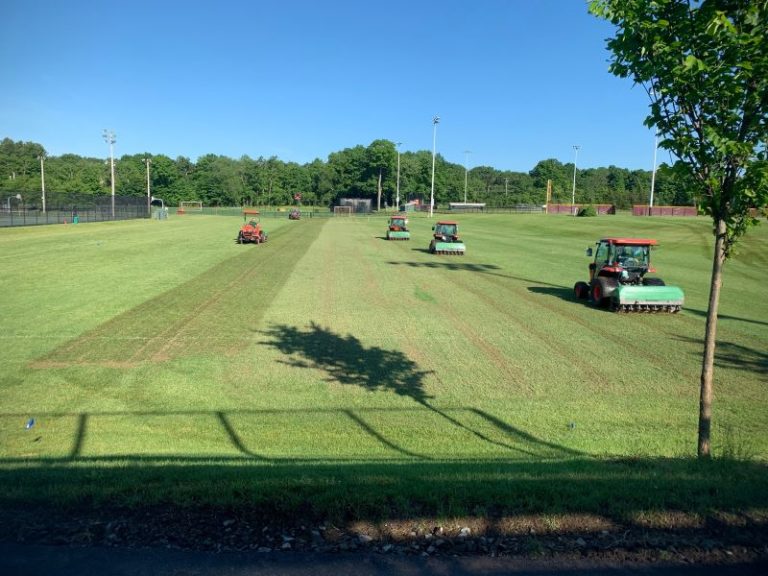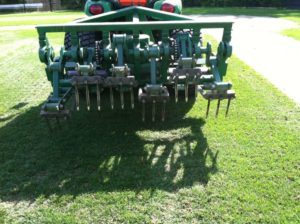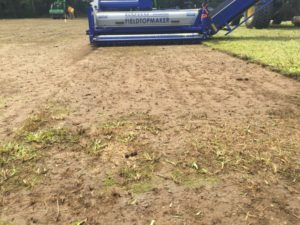Cultivation practices disturb the soil or thatch through the use of implements to relieve soil compaction, support thatch/organic matter reduction, and improve the opportunity for a healthy water and air exchange. However, cultivation should be used judiciously as it can disrupt field use and require significant time for recovery.
Cultivation frequency should be determined by the amount and timing of field use, degree of soil compaction, soil type, and the amount of accumulation of excessive thatch and organic matter. Excessive organic matter reduces root growth, encourages disease, and creates undesirable playing conditions. Cultivation events can be stressful to turfgrass, so they should occur when turfgrass recovery potential is optimized, aiding in the quick recovery of surface density. If done improperly, cultivation can decrease lateral stem and root growth.
Cultivation methods
Cultivation events vary in the degree of injury or stress to the turfgrass plant. Some cultivation tactics can be used during the playing season with minimal disruption to the playing surface. Some cultivation methods are more aggressive, increasing the time required for turfgrass recovery. If shallow irrigation pipes are present, they should be taken into consideration in terms of cultivation method and depth.
Hollow tining
Hollow tining is the most effective practice for relieving soil compaction, increasing oxygen levels in the rootzone, and aiding in improvement of soil drainage by physically removing small cores from the soil profile. Cores are usually 0.25” to 0.75” in diameter, with depths ranging from 3” to 10”. Working depths depend on equipment and soil conditions. Surface disruption potential is high with hollow tining, often requiring several days to a few weeks before the effects are no longer visible. While the cores can be harvested, they are frequently allowed to dry and then dragged back over the surface to serve as topdressing.
Solid tining
Solid tining causes less disturbance to the field surface than hollow tining and can be used to immediately create channels for water infiltration, temporarily reduce compaction, and soften surface hardness. However, the benefits of solid-tine cultivation are temporary because no soil is removed from the profile, except when using a deep tine aerator with a “kicking action” that results in some soil fracturing. “Venting” or “needle-tining” is often used to describe the practice of solid tine cultivation using small-diameter tines (0.25” to 0.375” in diameter). This is an effective tool that can increase gas exchange to root systems. It is primarily employed during times when the turfgrass is under stress and/or use of the field does not permit more aggressive cultivation.
Spiking/slicing
Spiking/slicing reduces surface compaction and promotes water infiltration with minimal surface damage. Slicing is a faster cultivation process than core cultivation but is less effective in reducing compaction. Spiking can break up crusts on the soil surface and enhances lateral spread of creeping grasses since it severs rhizomes and stolons. The effects on surface compaction and water infiltration are short lived as the slits rapidly close from traffic (play or maintenance equipment) on the surface. Recent equipment advancements have led to the use of deep slicer units (up to 15” depths possible) that provide a response called “linear decompaction.” The benefits of the machine are essentially immediate improvements in water infiltration and percolation through the profile with very limited surface disruption. The vibration of the machine during operation also has been shown to fracture subsurface soil layers.
Deep drilling
Deep-drill cultivation creates deep holes in the soil profile through use of drill bits. As the name implies, the hole depths are typically 9” to 12”. Soil is brought to the surface and distributed into the canopy. Holes can be backfilled with new rootzone materials if a drill-and-fill machine is used. These machines allow replacement of clay/silt soils with sand or other soil amendments in an effort to improve water infiltration into the soil profile.
Water and air injection
Water injection machines use a blast of water to create a hole and a vacuum to pull soil material into the hole. While this is disruptive to play on the field surface, the disruption is not long lasting. Air injection machines utilize tines that penetrate the soil and inject a burst of air near the maximum depth of penetration. For specific high-traffic areas, air injection machines are now regularly used and have slight surface disruption.
Vertical mowing
Vertical mowing (verticutting) can be incorporated into a cultural management program to achieve several goals. The grain of the sports field can be reduced by setting a verticutter to a depth that just nicks the surface of the turfgrass. Deeper penetration of knives stimulates new growth by cutting through stolons and rhizomes while removing accumulated thatch. Deep vertical mowing (0.5” to 1” depth) removes a greater amount of thatch than core cultivation and can be considered for aggressive thatch removal as it can remove up to 15% of the thatch at one time. However, it is aggressive and should only be done during less stressful times (e.g., cooler temperatures) and on well-rooted turfgrass. Unlike deep vertical mowing, shallow vertical mowing (0.5” or less) does not remove thatch. Instead, it severs rhizomes or stolons promoting new growth and standing up blades to allow removal of old growth and minor canopy thinning. Shallow vertical mowing can be practiced regularly during the growing season except in times of drought or excessive heat.
Fraise mowing
Fraise mowing is a cultural practice that was devised in the Netherlands during the mid-1990s and is similar to vertical mowing. While vertical mowing partially impacts the surface, fraise mowing’s impact is absolute, encompassing 100% of the surface and potentially reaching up to 2” depths in a single pass. This makes fraise mowing an appealing thatch management tool. Other demonstrated benefits of fraise mowing include Poa annua control and overseeding removal (McCauley et al., 2019; Brosnan et al., 2020). While fraise mowing was originally developed to mechanically harvest annual bluegrass plants from cool-season sports fields, its use has expanded from cool-season sports fields to warm-season bermudagrass sports fields.
This very important field rejuvenation tool removes sports fields from play for at least eight to 10 weeks under ideal growing conditions and restores “new field” conditions, vigor, and growth rates. With renovation of cool-season fields, often aggressive overseeding immediately follows a fraise mowing event. Fraise mowing can also help smooth uneven fields, removing high spots. Fraise mowing should only be undertaken under optimal turfgrass growing conditions.
Topdressing
Topdressing is often combined with core cultivation practices. Topdressing is the application of a uniform thin layer of soil, sand, or compost over the turfgrass surface. Frequent topdressing can level the playing field when minor variations or depressions are apparent, amend physical soil properties, create a better growing environment for the turfgrass, reduce thatch, and dilute organic matter.
Selecting an appropriate topdressing material is a critical aspect of a topdressing program. The topdressing material must be consistent in type and particle size to the existing rootzone, as well as be available for future topdressing. Variations in particle size can lead to layering, which impedes drainage and rooting.
Rolling
Rolling is often performed on sports fields to help smooth surfaces and produce a firm surface to increase ball roll speed (e.g., soccer) or improve ball bounce (e.g., baseball, tennis). Freeze/thaw cycles often lead to frost heave of soils, causing uneven playing surfaces. In these cases, lightweight rolling is often the quickest way to smooth these soils. If done in conjunction with a standard cultivation program to mitigate surface compaction, rolling is a very valuable tool to enhance playability.
Some research has shown that rolling can reduce disease incidence on low cut sports fields. This reduction in disease incidence is directly related to the use of lightweight rollers used first thing in the morning, whereby the roller is helping to remove dew/guttation water from the leaf tissue.
As with all cultural practices, rolling should be done under the appropriate field conditions in order to reduce stress. Adequate soil moisture (but not saturation) reduces the potential for compaction. For more information, see Rolling Athletic Fields on The Ohio State University’s Sports Turf Management website.
PGRs
Plant growth regulators (PGRs) are frequently used to reduce clipping yield, improve stress tolerance, and improve turfgrass quality and performance, including lateral shear strength of the turfgrass canopy, a factor in footing and traction by the athlete. PGRs can also be added to paint mixtures to extend the life of field markings on practice or low-input fields. An additional benefit of using PGRs can be the possible reduction in the use of other inputs, such as irrigation and decreased mowing.
PGRs require frequent reapplication during the growing season to maintain consistent growth suppression, but excessive PGR use in either rate or frequency can result in undesirable side effects. These side effects might include mild discoloration, stressed turfgrass, and segregation of grasses. These effects can be confused with disease and can intensify damage from pests and traffic. Some turfgrasses may also experience a rebound effect when the growth regulation wears off, resulting in a temporary flush of top growth.
Warm- and cool-season grasses (and even some cultivars within species) often vary in response to PGRs. Label recommendations should be very carefully followed, in conjunction with site-specific experimentation to evaluate the levels and frequency that best meet site-specific needs.
The best approach to planning PGR applications is to use growing degree day (GDD) thresholds instead of a calendar-based schedule. Free tools are available online for assistance in using GDD information to schedule PGR applications.
Wetting agents
Wetting agents can be used for a number of reasons, such as:
- Preventing dry spot development.
- Treating dry spots.
- Moving water into and through the soil.
- Improving irrigation efficiency.
- Serving as a spray adjuvant when applying pesticides or PGRs.
Wetting agents are especially helpful when applied to sandy soils that can become hydrophobic (water repellent). Turfgrass grown on sand-based rootzones can develop severe localized dry spots (LDS) especially when the turfgrass is irrigated deep and infrequently. Surfactants help promote water infiltration into these hydrophobic areas, which prevents and alleviates LDS .
Research shows preventative applications of wetting agents can increase soil water uniformity and sustain high visual turfgrass quality at very low levels of irrigation (30% potential ET). Preventive applications of wetting agents can also increase irrigation precision, potentially reducing water usage.
On Tuesday, January 18, from 11 a.m. – Noon, at the 2022 STMA Conference in Savannah, Ga., Victoria Wallace, University of Connecticut; Jason Bowers, CSFM, Parks System in Maryland; and Ben Polimer, Town of Weston, Mass., will present “Understanding the Value of STMA’s Best Practices Document.” This presentation will introduce the “Best Practices” document and discuss how these best practices advance the protection of the environment, support the sports field manager, and elevate the professionalism of the industry. For more information about the 2022 STMA Conference and Exhibition, visit https://www.stma.org/conference/




